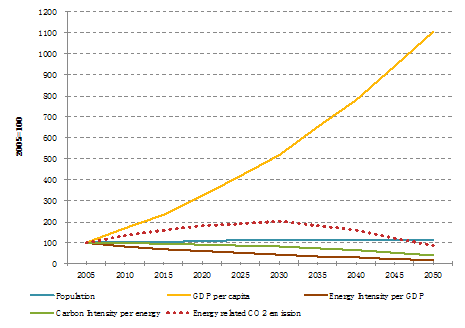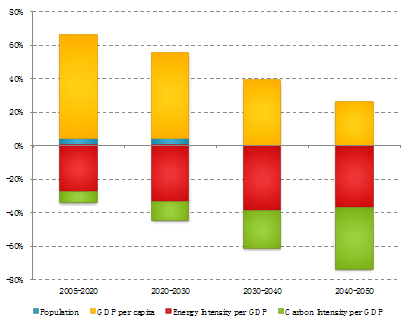Comments on China’s new emission cutting targets
chinagate.cn, July 3, 2015 Adjust font size:
China National Center for Climate Change Strategy and International Cooperation (NCSC)
Fu Sha, Zou Ji, Liu Linwei
Translated by China Carbon Forum
On 30 June 2015, the Chinese government submitted its Intended Nationally Determined Contribution (INDC), announcing its commitment to climate change mitigation and adaptation actions for the post-2020 period. China has nationally determined its actions by 2030 as follows:
•To achieve the peaking of carbon dioxide emissions around 2030 and making best efforts to peak early;
•To lower carbon dioxide emissions per unit of GDP by 60% to 65% from the 2005 level;
•To increase the share of non-fossil fuels in primary energy consumption to around 20%; and
•To increase the forest stock volume by around 4.5 billion cubic meters over the 2005 level.
•Moreover, China will continue to proactively adapt to climate change by enhancing mechanisms and capacities to effectively defend against climate change risks in key areas such as agriculture, forestry and water resources, as well as in cities, coastal and ecologically vulnerable areas and to progressively strengthen early warning and emergency response systems and disaster prevention and reduction mechanisms.
This article provides an analysis of China’s INDC in terms of the motivation and considerations in proposing it, its level of ambition and fairness, as well as difficulties and challenges facing China in achieving its contribution.
1.China’s considerations in proposing its INDC
The recent IPCC Fifth Assessment Report further confirmed the imminence of climate change based on science and observed facts. It has become a major international challenge to effectively address climate change and to achieve the target of keeping the increase in global average temperature below 2°C. Around the world, low-carbon development is the trend, and it is a necessary condition to achieving sustainable development. In this context, the basis and motivation for countries in proposing their INDCs should be to ensure successful resilience to the risks of climate change, and to realize fair opportunities in sustainable and low-carbon development.
Even though China has become the world’s largest carbon emitter and the second-largest economy, its main development indicators and its ongoing dual economic structure of urban and rural areas demonstrate the fact that it is still a developing country, implying huge differences between China and developed countries in terms of stage of development, development needs, historical responsibilities and comprehensive capabilities. China’s foremost strategic priority remains poverty reduction, raising incomes, increasing the level of social security, increasing the coverage of public services including basic infrastructure, raising the standard of living, etc. Meanwhile, its traditional growth model relying on high factor inputs is no longer sustainable. China is facing the risk of falling into the “middle-income trap”, constrained by resources and environmental conditions. This requires China to innovate its development pathway to upgrade its economic growth model to the “new normal”, to transform the main driver of economic growth from high quantity of factor inputs to high efficiency of inputs, to reduce dependence on energy, resources and environmental inputs, to cultivate new economic growth points and competitiveness, and to adopt a low-carbon development pathway with efficient use of factors of production.
A system of indicators was chosen for China’s INDC which reflects the transformation and innovation of its development pathway, including an intended peaking time target and quantitative indicators designed to evaluate the transformational process focused on boosting carbon efficiency (including indicators for carbon intensity, share of non-fossil fuels, and carbon sinks). China is committed to changing its development pathway, striving to explore an innovative, sustainable and low-carbon pathway, different from the traditional development pathways of the U.S and the EU, and focusing on improving technological, financial and other necessary conditions, establishing a suitable environment for development.
In order to implement the INDC mandate to cover all relevant factors (mitigation, adaptation, finance, technology development and transfer, capacity building and transparency) and to effectively address existing climate risks, China’s INDC also contains a number of planned measures and policies for adaptation to climate change. Meanwhile, China proposed in its INDC that it will further strengthen south-south cooperation on climate change. It will establish a fund for south-south cooperation on climate change, comprehensively expanding the scale and scope of south-south cooperation on climate change.
2.Level of ambition and fairness of China’s INDC
Generally, China’s INDC demonstrates China’s attitude and determination to actively address climate change, to endeavor to control greenhouse gas emissions, to enhance its capability to adapt to climate change, as well as to fully engage in global governance and take on reasonable international commitments.
A.By implementing its INDC, China’s economic growth will achieve further decoupling from carbon emissions
As can be seen from Table 1 and Figure 1, economic growth is the major contributor to the increase in China’s carbon dioxide emissions. By 2020, 2030 and 2050, China’s GDP per capita will be 3.2 times, 5.2 times and 11 times the 2005 level, respectively. Through implementation of the INDC, China’s energy-related CO2 emissions will be only 1.8 times, 2 times and 0.84 times its 2005 level over the same period, respectively. The link between China’s economic growth and carbon emissions will be decoupled, that is to say, the economy’s dependence on carbon emissions will be reduced, creating more favorable conditions for transformation towards a low-carbon development pathway.
The major reason for the decoupling will be the decrease in energy intensity per unit of GDP (benefitting from adjustment of industrial structure and improvement of energy efficiency) and the decarbonization of China’s energy structure. By 2030 and 2050, China’s energy intensity per unit of GDP will experience a drop of around 57% and 82% respectively over the 2005 level, while its carbon intensity per unit of energy will drop by 20% and 61% comparing to 2005, respectively.
In particular, during the period of 2005 to 2020 and the period of 2020 to 2030, the contribution from decreasing energy intensity per unit of GDP will be more important than the contribution from the decarbonization of the energy structure. From 2030 afterwards, the impact of the latter factor will be greater.
Table 1 Major factors in implementation of China’s INDC (2005=100)
Sources: Data of 2005 and 2010 are from China Statistical Yearbook, China Energy Statistical Yearbook and the China’s official review of target completion. Data after 2015 is developed based on INDC scenario study results calculated by the PECE model of NCSC and Renmin University of China.
Figure 1-1 Change of major driving factors after the implementation of INDC in China (2005 = 100)
Figure 1-2 Decomposition of the change in China’s energy–related CO2 emissions
Sources: Data of 2005 and 2010 are from China Statistical Yearbook, China Energy Statistical Yearbook and the China’s official review of target completion. Data after 2015 is developed based on INDC scenario study results calculated by the PECE model of NCSC and Renmin University of China.


